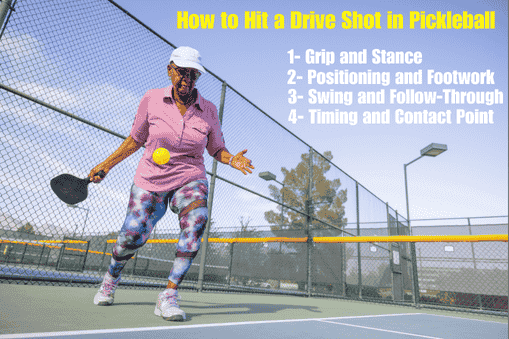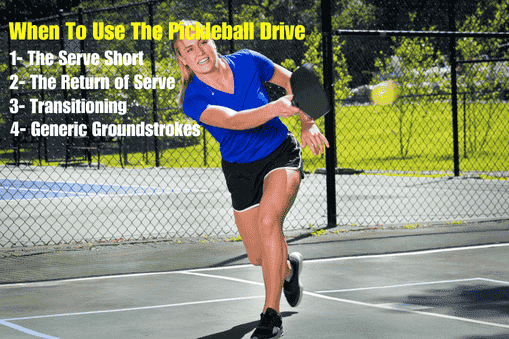No products in the cart.
The Drive Shot in Pickleball: Hit Hard and Win Big
In pickleball, mastering the drive shot is essential for any player looking to gain an edge. A strong swing with the right power and precision can make all the difference when sending the ball low and fast over the net, keeping opponents on their toes.
Using an Eastern grip and a square stance, a well executed shot starts by placing the non-dominant hand on the throat of the paddle, ensuring control.

As you load your shot with a C shape, the key is to rotate your hips and shoulders, allowing a smooth swing through the ball. Stepping forward into the shot helps maintain balance and finish high, adding both speed and control.
This technique not only adds variety to your game but also provides a way to take control of crucial matches. Today, let’s explore how refining this shot can elevate your overall strategy and execution.
What is a Drive Shot in Pickleball?
In pickleball, the drive shot is a powerful, low-trajectory shot designed to put pressure on the opponent by forcing a weak return. This shot is commonly used from the baseline or midcourt to drive the ball fast and keep opponents in a defensive position.
A strong Eastern grip, proper footwork, and a smooth full-body rotation help generate the necessary power and precision to execute this shot effectively. Unlike softer shots like dinks and drops, the drive shot is meant to create an aggressive return Short opportunity, disrupting the opponent’s rhythm.
Mastering the right precise technique and having good timing can make this an essential tool in any player’s game.
Understanding Your Playstyle: Power vs. Precision
When I first started playing pickleball, I quickly realized that players tend to fall into two categories those who rely on power and those who master precision.
If you love sending the ball flying with a fast shot, you are likely a hard hitting player who thrives on aggressive play.
But if you prefer controlled placements, using soft hands to guide the trajectory of the drive, then you lean toward finesse. Developing a winning approach means recognizing your strengths whether you dominate with sheer force or use strategic thinking to outmaneuver opponents.
Some excel by blending both styles, switching between an explosive strategy and delicate finesse when needed. No matter your preference, understanding your natural tendencies can refine your pickleball skills and help to become a professional pickleball player
How to Hit a Drive Shot in Pickleball

A powerful drive shot in pickleball isn’t just about force it’s about smart execution. To strike an effective shot, you need proper mechanics, solid positioning, and the right grip for control.
Your swing and motion should be smooth yet strong, using both upper body strength and strategic thinking to outplay your opponents.
But don’t rely on it too often hitting drives sparingly ensures you don’t become predictable. The real strategy lies in mixing up your different shots in pickleball, keeping your opponent guessing, and maintaining an element of surprise.
A fundamental part of the game is knowing when to unleash a drive and when to hold back. Let’s break down the key steps to hitting a successful drive shot in pickleball
Grip and Stance
To master the drive shot in pickleball, the first step is to get the grip and stance right. The continental grip offers versatility, allowing you to execute both forehand short and backhand shots effectively.
Your stance is just as important keep your feet shoulder-width apart, with knees slightly bent, and distribute your weight evenly.
A slight lean forward will help with momentum as you prepare for the shot. As the ball comes toward you, step in with your dominant foot to build up speed and power.
Keep your positioning tight, making sure your swing and motion are fluid for better control.
This will keep your opponents on their toes, guessing your next move, and make the drive shot more effective when mixed with strategic thinking and fundamental technique.
Positioning and Footwork
When hitting a drive, your footwork plays a pivotal role in ensuring a solid shot. A well-timed move to the spot where the ball will bounce allows you to position yourself properly, either for a forehand or topspin shot.
It all starts with stepping into the ball using your front foot while rotating your body slightly, engaging your torso and legs to generate power. Don’t just rely on your arms instead, leverage the momentum from your lower body for greater force.
Keep your paddle in a ready position, with your hands firm yet flexible for quick adjustments. As you approach a ball that’s easier to attack, you’ll find yourself able to step in confidently, using your body weight to add more strength to the shot.
Remember, good footwork means getting your feet into position early, setting up for the perfect point of contact, usually just in front of your body. Shifting your weight from your back foot to your front foot will help you maintain balance as you swing through the ball, delivering that powerful drive.
Swing and Follow-Through
When executing a drive shot in pickleball, it’s crucial to use a low-to-high swing motion. This technique helps lift the ball over the net, keeping it low enough to force your opponents into a defensive position.
As you swing, angle your paddle slightly upward to generate the necessary lift, but be mindful not to send the ball too high, which could make it easier for your opponent to return.
On contact, make sure to extend your arm fully and follow through smoothly, maintaining both power and accuracy.
A firm wrist during the shot is essential to prevent uncontrolled flicks, ensuring you hit a controlled shot every time. This precise movement will help keep your shots consistent and effective.
Timing and Contact Point
To execute a successful drive shot in pickleball, timing is critical. You should aim to contact the ball around waist height or just below it, as this gives you the best control over both the trajectory and power.
Striking too early or too late can result in weak, inaccurate shots, giving your opponents an advantage. Always aim to strike the ball in front of your body, where you can generate the most power and accuracy.
By making contact at the right point, you can adjust the speed and direction of your shot, making it much harder for the opponent to return. The spin you generate is also crucial, so ensure you’re lifting your paddle from low to high through the ball, adding that necessary Cross court dink to keep it controlled.
How To Drive the Ball with Power?
To generate maximum power in your pickleball drive shot, start by using your legs. Bending your knees and transferring your weight from your back foot to your front foot as you swing creates momentum that adds force to your shot.
It’s crucial to engage your core by rotating your torso, ensuring your body contributes to the overall power.
Make sure to follow through completely by extending your arm and continuing the motion after contact.
Keep a firm, but not too tight, grip on your paddle to maintain better control and strength during the shot, allowing for a more powerful, precise drive.
When To Use The Pickleball Drive

The Serve Short
When your opponent serves a short ball, it’s a great chance to drive the ball and apply pressure on them.
As the ball comes in short, you can target the baseline players to make it harder for them to return. A well executed drive down the center of the court or to a weaker shot of your opponent can increase your chances of putting them on the defensive.
This tactic helps to shift the dynamics of the game and set up your next shot effectively.
The Return of Serve
Return a serve short can be equally effective if you or your partner hits a strong serve that forces your opponent into a weaker return.
The moment they send a short return, seize the opportunity and attack with a heavy drive down the middle.
This move not only has the potential to win the point outright but also can set you up for an easy follow-up shot.
By using the drive in this scenario, you gain control of the point and force your opponent into a defensive position.
Transitioning
In the transition zone, timing is crucial. If the ball comes at a speed that’s easier for you to attack, it’s an excellent opportunity to take control and cut down your opponent’s reaction time.
However, be mindful that the ball should be high enough to strike cleanly. A ball that sits up high enough to attack gives you the edge to make a decisive shot.
If you strike it correctly in this zone, you can turn the tables in your favor during the critical moments of the game.
Generic Groundstrokes
During singles or doubles, when you find yourself at the back of the court, the opportunity to drive the ball often arises. Singles tends to provide more of these opportunities, as it’s centered on groundstrokes. I always advise players to mix up their shots to keep their opponent guessing. A well-timed drive forces the opponent into a defensive position, which is crucial for dictating the pace of the match and creating openings for your next move.
Common Mistakes With The Pickleball Drive
The drive can be tricky to master, especially if you’re new to racket sports. Here are some common mistakes in pickleball we often see with the pickleball drive:
Hitting In The Net
One mistake many players make is gripping the paddle too tight, which disrupts their natural swing. A tense grip prevents smooth movement, increasing the chances of hitting into the net.
Instead, staying relaxing under pressure allows for better ball control and reduces errors. Keeping a loose but firm hold on the paddle ensures the ball clears the net more consistently.
Hitting Too Flat
Some players struggle with hitting the ball with proper spin, which makes their shots hard to control. A well-placed topspin drive is your best friend, as it lets you add speed while keeping the ball in play. If you’re unsure how to apply topspin, many articles and videos can help.
The TopspinPro was designed to develop the correct biomechanics and build muscle memory for a consistent shot. Mastering this technique can significantly improve your offensive game.
Hitting Long
Another common mistake is sending the ball too long due to an excited swing. When the ball drops short, the temptation to whack it hard is high, but without proper topspin, it may sail past the baseline.
Various factors can contribute to this, including overuse of power and improper paddle angles. Learning to control aggression and applying spin helps keep the ball in play.
Reacting Too Slowly
A key part of a strong pickleball drive is anticipating the ball and executing quickly. If you react too slow, you might miss the opportunity to attack or make a strong shot.
Slow reactions lead to mishits and loss of control, making it crucial to train with a partner or a machine. Drills that focus on moving smoothly and quickly can help you notice and strike short balls at the right time, improving overall performance.
In Conclusion
Mastering the pickleball drive takes practice, especially if you’re new to racket sports. Avoiding common mistakes like improper grip, poor timing, or lack of follow-through can make a big difference in your game.
Focus on technique, stay patient, and keep refining your shots. With time and practice, your drive will become a powerful tool on the court!








Add comment